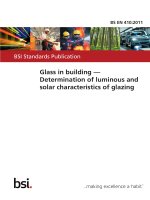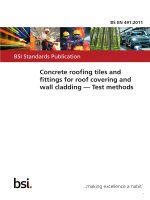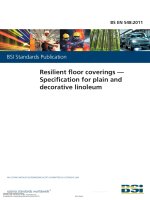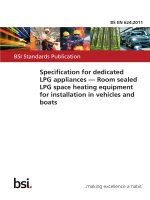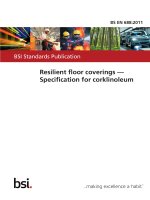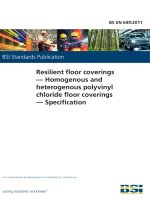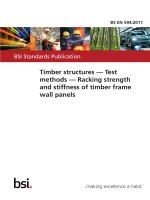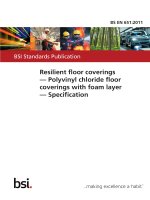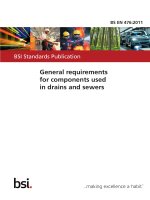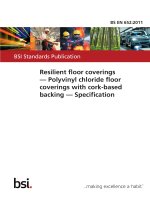Bsi bs en 61821 2011
Bạn đang xem bản rút gọn của tài liệu. Xem và tải ngay bản đầy đủ của tài liệu tại đây (1.04 MB, 34 trang )
BS EN 61821:2011
BSI Standards Publication
Electrical installations for
lighting and beaconing of
aerodromes — Maintenance of
aeronautical ground lighting
constant current series circuits
BS EN 61821:2011
BRITISH STANDARD
National foreword
This British Standard is the UK implementation of EN 61821:2011. It is
identical to IEC 618121:2011. It supersedes BS EN 61821:2003 which is
withdrawn.
The UK participation in its preparation was entrusted to Technical
Committee EPL/97, Aeronautical ground lighting.
A list of organizations represented on this committee can be obtained
on request to its secretary.
This publication does not purport to include all the necessary provisions
of a contract. Users are responsible for its correct application.
© The British Standards Institution 2012
ISBN 978 0 580 62064 5
ICS 29.140.50; 93.120
Compliance with a British Standard cannot confer immunity from
legal obligations.
This British Standard was published under the authority of the
Standards Policy and Strategy Committee on 31 January 2012.
Amendments issued since publication
Date
Text affected
BS EN 61821:2011
EUROPEAN STANDARD
EN 61821
NORME EUROPÉENNE
November 2011
EUROPÄISCHE NORM
ICS 29.140.50; 93.120
Supersedes EN 61821:2003
English version
Electrical installations for lighting and beaconing of aerodromes Maintenance of aeronautical ground lighting constant current series
circuits
(IEC 61821:2011)
Installations électriques pour l'éclairage et
le balisage des aérodromes Maintenance des circuits série à courant
constant pour le balisage aéronautique au
sol
(CEI 61821:2011)
Elektrische Anlagen für Beleuchtung und
Befeuerung von Flugplätzen Wartung von KonstantstromSerienstromkreisen für
Flugplatzbefeuerungsanlagen
(IEC 61821:2011)
This European Standard was approved by CENELEC on 2011-11-03. CENELEC members are bound to comply
with the CEN/CENELEC Internal Regulations which stipulate the conditions for giving this European Standard
the status of a national standard without any alteration.
Up-to-date lists and bibliographical references concerning such national standards may be obtained on
application to the CEN-CENELEC Management Centre or to any CENELEC member.
This European Standard exists in three official versions (English, French, German). A version in any other
language made by translation under the responsibility of a CENELEC member into its own language and notified
to the CEN-CENELEC Management Centre has the same status as the official versions.
CENELEC members are the national electrotechnical committees of Austria, Belgium, Bulgaria, Croatia, Cyprus,
the Czech Republic, Denmark, Estonia, Finland, France, Germany, Greece, Hungary, Iceland, Ireland, Italy,
Latvia, Lithuania, Luxembourg, Malta, the Netherlands, Norway, Poland, Portugal, Romania, Slovakia, Slovenia,
Spain, Sweden, Switzerland and the United Kingdom.
CENELEC
European Committee for Electrotechnical Standardization
Comité Européen de Normalisation Electrotechnique
Europäisches Komitee für Elektrotechnische Normung
Management Centre: Avenue Marnix 17, B - 1000 Brussels
© 2011 CENELEC -
All rights of exploitation in any form and by any means reserved worldwide for CENELEC members.
Ref. No. EN 61821:2011 E
BS EN 61821:2011
EN 61821:2011
-2-
Foreword
The text of document 97/153/FDIS, future edition 2 of IEC 61821, prepared by IEC/TC 97 "Electrical
installations for lighting and beaconing of aerodromes" was submitted to the IEC-CENELEC parallel vote
and approved by CENELEC as EN 61821:2011.
The following dates are fixed:
•
•
latest date by which the document has
to be implemented at national level by
publication of an identical national
standard or by endorsement
latest date by which the national
standards conflicting with the
document have to be withdrawn
(dop)
2012-08-03
(dow)
2014-11-03
This document supersedes EN 61821:2003.
EN 61821:2011 includes the following significant technical changes with respect to EN 61821:2003:
a) addition of references to normative references;
b) addition of notes in Clauses 5, 6 and 7;
c) modification of pre-work procedures in item e) of 7.2.2.
Attention is drawn to the possibility that some of the elements of this document may be the subject of
patent rights. CENELEC [and/or CEN] shall not be held responsible for identifying any or all such patent
rights.
Endorsement notice
The text of the International Standard IEC 61821:2011 was approved by CENELEC as a European
Standard without any modification.
In the official version, for Bibliography, the following notes have to be added for the standards indicated:
IEC 61822
NOTE Harmonized as EN 61822.
IEC 61823
NOTE Harmonized as EN 61823.
BS EN 61821:2011
-3-
EN 61821:2011
Annex ZA
(normative)
Normative references to international publications
with their corresponding European publications
The following referenced documents are indispensable for the application of this document. For dated
references, only the edition cited applies. For undated references, the latest edition of the referenced
document (including any amendments) applies.
NOTE When an international publication has been modified by common modifications, indicated by (mod), the relevant EN/HD
applies.
Publication
Year
Title
EN/HD
Year
IEC 60903
-
Live working - Gloves of insulating material
EN 60903
-
BS EN 61821:2011
–2–
61821 © IEC:2011
CONTENTS
FOREWORD ........................................................................................................................... 3
INTRODUCTION ..................................................................................................................... 5
1
Scope ............................................................................................................................... 6
2
Normative references ....................................................................................................... 6
3
Terms and definitions ....................................................................................................... 6
4
Competence of persons .................................................................................................... 9
5
4.1 Objective ................................................................................................................. 9
4.2 Requirements .......................................................................................................... 9
Management of maintenance activities ............................................................................. 9
5.1
5.2
6
Objective ................................................................................................................. 9
Requirements .......................................................................................................... 9
5.2.1 Organizational roles and responsibilities ...................................................... 9
5.2.2 Use of contractors ..................................................................................... 10
5.2.3 Maintenance policy .................................................................................... 10
5.2.4 Maintenance procedures ........................................................................... 11
5.2.5 Admittance to AGL work areas .................................................................. 11
Safety requirements ....................................................................................................... 12
6.1
6.2
7
Objective ............................................................................................................... 12
Requirements ........................................................................................................ 12
6.2.1 Safety procedures ..................................................................................... 12
6.2.2 Live working .............................................................................................. 13
6.2.3 Safety checks ............................................................................................ 13
6.2.4 Tools and test equipment .......................................................................... 14
6.2.5 Safety equipment....................................................................................... 14
6.2.6 Personal protective equipment................................................................... 14
AGL maintenance procedures ......................................................................................... 14
7.1
7.2
Objective ............................................................................................................... 14
Requirements ........................................................................................................ 14
7.2.1 General ..................................................................................................... 14
7.2.2 Pre-work procedures ................................................................................. 14
7.2.3 AGL constant current series circuits .......................................................... 15
7.2.4 Cables ....................................................................................................... 15
7.2.5 Completion of work .................................................................................... 16
7.2.6 Records and documentation ...................................................................... 16
Annex A (informative) Maintenance organisation model ....................................................... 17
Bibliography .......................................................................................................................... 27
Figure A.1 – AGL maintenance organisation structural diagram ............................................ 18
Figure A.2 – AGL constant current series circuit maintenance model .................................... 24
Figure A.3 – Example of a permit-to-work/sanction-to-test sheet ........................................... 25
Figure A.4 – Example of a permit-to-work/sanction-to-test sheet ........................................... 26
BS EN 61821:2011
61821 © IEC:2011
–3 –
INTERNATIONAL ELECTROTECHNICAL COMMISSION
____________
ELECTRICAL INSTALLATIONS FOR LIGHTING
AND BEACONING OF AERODROMES –
MAINTENANCE OF AERONAUTICAL GROUND LIGHTING
CONSTANT CURRENT SERIES CIRCUITS
FOREWORD
1) The International Electrotechnical Commission (IEC) is a worldwide organization for standardization comprising
all national electrotechnical committees (IEC National Committees). The object of IEC is to promote
international co-operation on all questions concerning standardization in the electrical and electronic fields. To
this end and in addition to other activities, IEC publishes International Standards, Technical Specifications,
Technical Reports, Publicly Available Specifications (PAS) and Guides (hereafter referred to as “IEC
Publication(s)”). Their preparation is entrusted to technical committees; any IEC National Committee interested
in the subject dealt with may participate in this preparatory work. International, governmental and nongovernmental organizations liaising with the IEC also participate in this preparation. IEC collaborates closely
with the International Organization for Standardization (ISO) in accordance with conditions determined by
agreement between the two organizations.
2) The formal decisions or agreements of IEC on technical matters express, as nearly as possible, an international
consensus of opinion on the relevant subjects since each technical committee has representation from all
interested IEC National Committees.
3) IEC Publications have the form of recommendations for international use and are accepted by IEC National
Committees in that sense. While all reasonable efforts are made to ensure that the technical content of IEC
Publications is accurate, IEC cannot be held responsible for the way in which they are used or for any
misinterpretation by any end user.
4) In order to promote international uniformity, IEC National Committees undertake to apply IEC Publications
transparently to the maximum extent possible in their national and regional publications. Any divergence
between any IEC Publication and the corresponding national or regional publication shall be clearly indicated in
the latter.
5) IEC itself does not provide any attestation of conformity. Independent certification bodies provide conformity
assessment services and, in some areas, access to IEC marks of conformity. IEC is not responsible for any
services carried out by independent certification bodies.
6) All users should ensure that they have the latest edition of this publication.
7) No liability shall attach to IEC or its directors, employees, servants or agents including individual experts and
members of its technical committees and IEC National Committees for any personal injury, property damage or
other damage of any nature whatsoever, whether direct or indirect, or for costs (including legal fees) and
expenses arising out of the publication, use of, or reliance upon, this IEC Publication or any other IEC
Publications.
8) Attention is drawn to the Normative references cited in this publication. Use of the referenced publications is
indispensable for the correct application of this publication.
9) Attention is drawn to the possibility that some of the elements of this IEC Publication may be the subject of
patent rights. IEC shall not be held responsible for identifying any or all such patent rights.
International Standard IEC 61821 has been prepared by IEC technical committee 97:
Electrical installations for lighting and beaconing of aerodromes.
This second edition cancels and replaces the first edition published in 2002. It is a technical
revision.
This edition includes the following significant technical changes with respect to the previous
edition:
a) addition of references to normative references;
b) addition of notes in Clauses 5, 6 and 7;
c) modification of pre-work procedures in item e) of 7.2.2.
BS EN 61821:2011
–4–
61821 © IEC:2011
The text of this standard is based on the following documents:
FDIS
Report on voting
97/153/FDIS
97/154/RVD
Full information on the voting for the approval of this standard can be found in the report on
voting indicated in the above table.
This publication has been drafted in accordance with the ISO/IEC Directives, Part 2.
The committee has decided that the contents of this publication will remain unchanged until
the stability date indicated on the IEC web site under "" in the data
related to the specific publication. At this date, the publication will be
•
•
•
•
reconfirmed,
withdrawn,
replaced by a revised edition, or
amended.
BS EN 61821:2011
61821 © IEC:2011
–5 –
INTRODUCTION
This International Standard contains the management, safety and procedural requirements
specific to the maintenance of an aeronautical ground lighting (AGL) constant current series
circuit and has taken into consideration existing national standards, requirements and
practices. The maintenance activities are required to ensure that the AGL constant current
series circuit continues to meet the operational requirements and minimize the occurrence of
operational failures.
To conform to this International Standard it should be demonstrated to the relevant bodies
that the requirements have been satisfied and therefore that the clause objective(s) has (have)
been met.
NOTE
•
Examples of relevant bodies would include the following:
certification and licensing authorities;
•
safety regulators;
•
notified bodies for international or European directives;
•
national standards bodies.
BS EN 61821:2011
–6–
61821 © IEC:2011
ELECTRICAL INSTALLATIONS FOR LIGHTING
AND BEACONING OF AERODROMES –
MAINTENANCE OF AERONAUTICAL GROUND LIGHTING
CONSTANT CURRENT SERIES CIRCUITS
1
Scope
This International Standard applies to the maintenance of AGL constant current series circuits.
This International Standard
•
covers constant current series circuits for AGL installed at aerodromes and heliports;
•
concentrates on providing the safety requirements for the maintenance of an AGL
constant current series circuit. It is recognized that AGL constant current series circuits of
different design characteristics and parameters are in existence;
•
is mainly concerned with safety to persons by specifying the rules and fundamental
principles for the maintenance of AGL constant current series circuits;
•
is not intended to apply to AGL primary series circuits supplied directly from a mains
constant voltage source;
•
is not intended to be used for public street lighting, roadway lighting or any other
installation requiring the use of constant current series circuits.
2
Normative references
The following referenced documents are indispensable for the application of this document.
For dated references, only the edition cited applies. For undated references, the latest edition
of the referenced document (including any amendments) applies.
IEC 60903, Live working – Gloves of insulating material
3
Terms and definitions
For the purposes of this document, the following terms and definitions apply.
3.1
aerodrome authority
organization accountable for the operational safety and security of persons, aircraft
operations and facilities at an aerodrome
NOTE Temporally the occupational safety for third party personal, contracted for AGL work on non-operational
areas, can be delegated to the third party contractor if the evidence of professional skills, knowledge of the
behavior rules and the separation to the airport operation area is given and documented.
3.2
AGL constant current series circuit
apparatus configured as an electrical circuit designed to produce and operate with a constant
current, independent of specified load variations, in order to provide a specified light for
aeronautical purposes
3.3
AGL operator
person responsible for the control of the AGL to permit the safe movement of aircraft
BS EN 61821:2011
61821 © IEC:2011
–7 –
3.4
caution sign
non-metallic safety sign attached to equipment conveying a warning against interference with
such equipment
3.5
constant current regulator
CCR
apparatus which produces a current output at a constant r.m.s. value independent of variations in the constant current series circuit load, input voltage and service conditions as
specified
3.6
contractor
organization or person(s) given a written order to provide a service or undertake specified
work
3.7
dead
free from any electrical connection to a source of potential difference and from electric charge;
not having a potential different from that of the earth
3.8
earthed
connected to the general mass of earth in such a manner as to ensure at all times an
immediate discharge of electrical energy without harm
3.9
electrical equipment
anything used, intended to be used or installed for use, to generate, provide, transmit, transform, rectify, convert, conduct, distributes, control, store, measure or use electrical energy
3.10
harm
physical injury or damage to the health of people either directly, or indirectly, as a result of
damage to property or to the environment
[ISO/IEC Guide 51, 3.3, modified]
3.11
hazard
potential source of harm
NOTE The term includes hazards to persons arising within a short time scale (for example, fire and explosion)
and also those that have a long-term effect on a person’s health (for example, release of a toxic substance).
[ISO/IEC Guide 51, 3.5, modified]
3.12
hazardous event
occurrence, with possible hazardous consequences, arising as the result of a hazardous
condition
3.13
hazard sign
non-metallic safety sign that conveys a warning against risk of harm
BS EN 61821:2011
–8–
61821 © IEC:2011
3.14
isolate
disconnect and separate electrical equipment from the normal source(s) of electrical energy in
such a way that the disconnection and separation is secure
3.15
live
electrically connected to a source of electricity or which has acquired a charge by other
means
3.16
maintenance
act of diagnosing and physically repairing, or preventing, equipment failures
3.17
personal protective equipment
equipment used to protect persons from harm in the working environment
NOTE Personal protective equipment includes such items as special tools, protective clothing, insulating
screening, safety harnesses and safety signs.
3.18
prove dead
demonstrate with the use of test equipment that no electrical potential liable to cause harm is
present
3.19
risk
combination of the probability of occurrence of harm and the severity of that harm
[ISO/IEC Guide 51, 3.2]
3.20
risk assessment
1. systematic quantitative assessment of the magnitude of the threat to safety induced by the
accumulation of controlled and unresolved residual hazards;
2. integrated analysis of the risks inherent in a product, system or facility and their significance in an appropriate context
3.21
test equipment
equipment to undertake particular tests, that is suitable for the use for which it is provided,
that is maintained in a condition suitable for that use, and that is properly used
3.22
test/testing (of electrical equipment)
1. providing a sequence of operations or the measuring of electrical characteristics of live
electrical equipment (for example, diagnostic testing of faulty equipment);
2. applying voltages, currents or signals for the purposes of providing insulation, continuity or
other characteristic of isolated electrical equipment (for example, before a permanent
electrical installation is energised from the normal source(s) of electrical energy)
3.23
work/working (on electrical equipment)
installing, dismantling, assembling, maintaining, testing or repairing of electrical equipment
BS EN 61821:2011
61821 © IEC:2011
4
–9 –
Competence of persons
4.1
Objective
The objective of the requirements of this clause is to ensure that persons who have
responsibility for any activity, or are directly engaged in the maintenance of AGL constant
current series circuits are competent to discharge those duties or perform those tasks.
NOTE It is recommended that the appropriate administration or aerodrome authority encourage the development
of a formal and structured competency training programme(s). The training programme(s) should consist of multiple
tiers that enhance progressively a person’s skills and ensure a recognised level of competency for those persons
who have satisfactorily completed the programme(s).
4.2
Requirements
In accordance with national legislation, all persons involved in any activity, including management and maintenance activities, shall have the appropriate and verifiable training, technical
knowledge, experience and qualifications relevant to the specific duties they have to perform.
In particular, where involved in work on constant current series circuits, they shall be
knowledgeable of the specific risks and the safety procedures involved in the work. The
training, experience and qualifications of all persons involved in any activity shall be justified
taking into account all the relevant competence factors. The justification shall be recorded in
appropriate documentation.
NOTE The following competence factors should be addressed when assessing and justifying the competence of
persons carrying out their duties:
•
engineering appropriate to the application area;
•
engineering appropriate to the technology (for example, mechanical, electrical/electronic/software engineering);
•
safety engineering appropriate to the technology;
•
knowledge of the legal and safety regulatory framework;
•
knowledge of the operational aspects related to the AGL system at the aerodrome;
•
the consequences in the event of a failure of a constant current series circuit;
•
the consequences of failure to adhere to safety procedures when working on constant current series circuits;
•
the novelty of the design, design procedures or application;
•
previous experience relevant to the specific duties to be performed and the technology being employed;
•
relevance of qualifications to the specific duties performed.
5
Management of maintenance activities
NOTE
Additional informative guidance material for management of maintenance activities is included in Annex A.
5.1
Objective
The objective of the requirements of this clause is to detail the roles and responsibilities of
those personnel engaged in maintenance activities on or near AGL constant current series
circuits and the procedures to ensure that safety are addressed.
5.2
Requirements
5.2.1
Organizational roles and responsibilities
The aerodrome authority shall appoint one or more named persons to manage, supervise or
undertake specific maintenance tasks. Those persons shall be identified on any applicable
record or other documentation associated with the task. All persons involved in work on the
AGL shall be aware of
•
their role and responsibilities;
•
their duties and how to perform those duties;
•
the procedures to be followed;
BS EN 61821:2011
10
ã
61821 â IEC:2011
contingency working arrangements.
The content of this clause is a minimum requirement.
NOTE IEC/TS 62143 contains details of requirements for the safety management of an AGL system at an
aerodrome.
5.2.2
Use of contractors
The aerodrome authority retains full accountability under these requirements for all work
undertaken on an AGL constant current series circuit by a contractor. This accountability shall
include where the AGL constant current series circuit, or part of it, is to be under the control
of a contractor. The aerodrome authority shall ensure that all other organisations, including
the users and operators of the AGL and other applicable aerodrome facilities, are notified
prior to the commencement of the work and the procedures used. Contractors and other nonaerodrome employees shall follow the safety rules and procedures provided by the aerodrome
authority (see 5.2.4).
5.2.3
Maintenance policy
5.2.3.1
Concept
A maintenance policy shall be produced and implemented. The maintenance policy shall
include the following aspects:
•
•
the maintenance philosophy, that includes and takes account of
–
the maintenance objectives;
–
the operational requirements;
–
the maintenance resources;
a maintenance schedule and procedures (see 5.2.4), which includes
–
planned, controlled, conditional and corrective maintenance programmes;
–
post-maintenance activities;
–
the modification or upgrading of equipment;
•
reference to the maintenance procedures (see 5.2.4);
•
reference to specific safety procedures (see 6.2.1);
•
the management of records and documentation (see 7.2.6);
•
the provision of spares, tools, test and safety equipment (see 6.2.4 and 6.2.5);
•
inspections (see 7.2);
•
provision for the review and amendment of the maintenance policy.
NOTE
Maintenance activities can be described as
•
planned, where prescribed tasks are carried out on a routine basis;
•
controlled, where an analysis of the equipment is carried out in order to minimize the amount of planned
maintenance required;
•
conditional, where the maintenance requirements have changed during the life of the equipment;
•
corrective, in order to restore equipment to the required operational state.
5.2.3.2
Operational aspects
The maintenance of AGL equipment shall consider the objectives of aerodrome operations
and address the impact on such operations whilst maintenance activities are being carried out.
NOTE
•
For example, the following should be considered:
the withdrawal of operational facilities and the closing of movement areas to aircraft operations prior to works;
BS EN 61821:2011
61821 â IEC:2011
11
ã
the return of operational facilities and movement areas when operationally necessary even though the works
may not be completed;
•
the raising of a notice to airmen (NOTAM) where work will affect the availability of operational facilities;
•
procedures for entering and being recalled from active operational areas;
•
precautions to prevent the possibility of foreign object damage (FOD) to aircraft by maintenance (particularly
vehicles) and excavating plant;
•
procedures for communication with the AGL operator before, during and after works.
5.2.4
5.2.4.1
Maintenance procedures
Procedures manual
Maintenance procedures that instruct on the correct and safe method of maintenance shall be
provided for each maintenance activity that is to be undertaken on the AGL. The maintenance
procedures shall be contained in a suitable document (for example, an AGL operation and
maintenance plan, see IEC/TS 62143) and shall be provided and used at all times. A copy of
the maintenance procedures shall be made available to all AGL maintenance personnel and
any contractors' representative(s). They shall read and understand the maintenance
procedures and their implication to both themselves and others. Ignorance of the procedures
shall not be accepted as an excuse for neglect of responsible action or failure to implement
them. The aerodrome authority shall keep an appropriately controlled record of this action.
Any questions of safety shall be raised with the aerodrome authority who shall have the
matter investigated and satisfactorily resolved before the applicable work commences.
In all appropriate work areas, there shall be access to the following items:
•
a copy of the maintenance procedures;
•
instructions and details of procedures designed to protect personnel;
•
applicable safety equipment;
•
all relevant and appropriate drawings of the equipment and its identification and location;
•
all relevant service manuals;
•
local safety and operational procedures.
5.2.4.2
Authorization procedures
The aerodrome authority shall determine which activities require authorization, who is able to
give the authorization, how the authorization, including written permission, is to be obtained,
and all other safety procedures associated with the activity. One method, a safe system of
work involving the issuance of permits/sanctions, is illustrated in Annex A. The authorization
procedures shall be outlined explicitly in a suitable document.
5.2.5
Admittance to AGL work areas
When entering an AGL indoor work area, all persons shall sign a logbook. The logbook shall
be located in the work area.
NOTE 1 Such work areas may include sub-stations, switchrooms, plant and machinery rooms, AGL control
centres, diesel generator rooms and electrical workshops.
NOTE 2
The logbook should contain the following information:
•
time of entry;
•
name and signature of all persons present;
•
reason for visit;
•
permit/sanction serial number (if applicable, see 5.2.4.2 and Annex A);
•
brief detail of the work to be carried out;
•
time of exit.
BS EN 61821:2011
– 12 –
6
61821 © IEC:2011
Safety requirements
NOTE Additional informative guidance material for management of maintenance activities which have impact on
safety to personnel engaged in maintenance activities is included in Annex A.
6.1
Objective
The objective of the requirements of this clause is to detail the measures to ensure
operational safety and safety to personnel engaged in maintenance activities on or near AGL
constant current series circuits.
6.2
Requirements
6.2.1
Safety procedures
The aerodrome authority shall perform a risk assessment of all work to be performed on AGL
constant current series circuits. A risk assessment shall include, inter alia, the determination
of the required manning level to complete the work safely. Care shall be taken to ensure that
maintenance equipment and other materials do not present a hazard to aircraft. The
completed risk assessments shall be contained in a suitable document and retained by the
aerodrome authority. They should be reviewed and updated periodically or whenever
necessary, for example, due to a hazardous event.
Safety procedures shall be developed that take into account the completed risk assessment
for the work and shall consider
•
that work shall not be performed on live electrical conductors or equipment, except where
special procedures shall be implemented to prevent harm (see 6.2.2);
•
that, where required, authorization to perform work or testing on AGL electrical equipment
shall be obtained prior to that work commencing and that the authorization shall remain
valid for the duration of the work (see 5.2.4.2 and Annex A);
•
that power shall always be assumed to be on and electrical equipment is live until the true
condition is determined (see 7.2.2);
•
that, unless determined otherwise by a risk assessment, at least two persons shall be
assigned to carry out maintenance work on AGL electrical equipment;
•
that maintenance procedures shall begin only after a visual inspection has been made and
possible hazards have been identified, evaluated in a risk assessment and recorded
(see 7.2.2);
•
that a specific safety training for personnel is provided;
•
that a safety protection device is intended to prevent hazards. The deliberate disconnection of such device shall only be authorized in accordance with specific safety
procedures (see 6.2.3.2);
•
the use of safety signs and instructions (see 6.2.3.3);
•
the availability of earth terminals and other safety facilities (see 6.2.3.4);
•
that some electrical equipment is exposed to weather and moisture and may develop
electrical shock hazards through damage from lightning or insulation deterioration from
exposure (see 6.2.3.5);
•
that all tools and test equipment shall be appropriate for the task (see 6.2.4);
•
the use of appropriate safety equipment (see 6.2.5);
•
the periodic inspection and/or calibration of tools, test and safety equipment (see 6.2.4
and 6.2.5);
•
that electrical equipment shall not be returned to operational service without verifying that
it is functioning correctly and that all the maintenance activities have been satisfactorily
completed (see 7.2.5).
BS EN 61821:2011
61821 © IEC:2011
6.2.2
–13 –
Live working
No work of any kind shall be performed on live AGL constant current series circuits unless the
aerodrome authority has undertaken a risk assessment and provided procedures that have
been assessed by that authority as safe. In this case, all practical precautions to prevent
harm shall be taken.
Fault finding or testing on live electrical equipment shall only be undertaken when it is
unreasonable for the electrical equipment to be made dead. Any subsequent repair shall not
be performed on live electrical equipment.
6.2.3
Safety checks
6.2.3.1
Securing the work area
Electrical equipment covers shall be replaced and doors closed whenever electrical
equipment is left unattended. If electrical equipment door locks are provided they shall be left
locked with keys made available for authorized use. Any electrical equipment in the vicinity of
the work in progress that cannot be made dead shall be identified and appropriate
precautions shall be taken to prevent any additional hazard.
6.2.3.2
Safety protection devices
Fault diagnosis may require defeating interlocks or the removal of covers to give access to
live electrical equipment (see 6.2.2). On such occasions testing shall be limited to the use of
appropriate test equipment and shall follow a formalized procedure. This procedure may
include a written checklist, agreed routines or any other precautions deemed necessary to
maintain safety. Where interlocks have been defeated or covers removed for test purposes,
the interlocks shall be re-instated and covers replaced at the earliest opportunity. The safety
protection devices shall be re-set, tested and verified as operating correctly before the
electrical equipment is returned to operational service.
6.2.3.3
Safety signs
The working area shall be screened off by suitable barriers and indicated by appropriate signs.
Caution signs shall be affixed to all switchgear controlling the electrical equipment which has
been made dead and on which work is proceeding. Hazard signs shall also be attached on, or
adjacent to, live electrical equipment and at the limits of the area in which work may be
carried out. In all cases a safety or job tag shall be securely attached at the point of isolation
giving the name of the person who carried out the isolation procedure, essential contact
telephone number(s) and date and time of isolation. If any test equipment or electrical
equipment under test cannot be placed within the screened area, it shall be separately
screened. Any safety signs that are not in use shall be stored in the appropriate place. A sign
or placard, giving details of emergency resuscitation in the event of electric shock and first aid,
shall be displayed in AGL indoor work areas where persons may be at risk of electric shock.
6.2.3.4
Earthing facilities
Earth connections shall be installed and maintained in conformance with the installation
instructions. Earth connections, including devices for providing the temporary connection of
an earth, shall be tested and the measurement recorded on a regular basis.
NOTE
cycle.
This test should take into account seasonal variations in the soil and should be performed on a nine-month
6.2.3.5
Proving circuit is dead
Where necessary (see 6.2.2), appropriate measures shall be taken to assure that the circuit
on which work is to be performed is dead. The circuit should be earthed during the time taken
to do the work (see 7.2.2 e)).
BS EN 61821:2011
– 14 –
NOTE
61821 © IEC:2011
A constant current series circuit may be live even when no voltage is detected at the test point.
6.2.3.6
Environmental factors
Electrical equipment that is normally covered but has to be exposed as a necessary result of
the maintenance activities shall be protected from water and other undesirable elements.
Work in exposed areas shall take account of adverse weather conditions, flora and fauna. No
work on an AGL constant current series circuit shall take place in the presence of lightning.
6.2.4
Tools and test equipment
Appropriate tools and test equipment shall be used at all times. All test equipment shall be
calibrated and be in good working order.
6.2.5
Safety equipment
Safety equipment shall be provided, worn and used wherever necessary. Adequate training
in the use, safe keeping and inspection of safety equipment shall be given to the user.
Before and after each occasion of use, the user shall inspect safety equipment for visible
defects and any suspect item shall be withdrawn and replaced. Periodic inspections shall be
recorded in a suitable document.
6.2.6
Personal protective equipment
Where required (see 6.2.1 and 6.2.2) rubber boots, insulating gloves, insulating mats and
other appropriate personal protective equipment shall be readily available at all times.
Insulating gloves shall be tested in accordance with IEC 60903 and shall be indelibly marked
with the date of the test. Insulating gloves tested more than 12 months previously shall not be
used and shall either be mutilated to prevent re-use or returned for testing.
NOTE Where insulating gloves are to be used for replacing lamps, potential heat hazards should be taken into
consideration.
7
AGL maintenance procedures
NOTE Additional informative guidance material for management of maintenance activities which have impact on
safety to personnel engaged in maintenance activities is included in Annex A.
7.1
Objective
The objective of the requirements of this clause is to detail the procedures to ensure
operational safety and safety to personnel engaged in maintenance activities on or near AGL
constant current series circuits.
7.2
7.2.1
Requirements
General
Where appropriate, manufacturer's recommendations shall be used for the maintenance of
specific electrical equipment including CCRs, AGL series transformers, and light fittings.
Defective electrical equipment shall be removed from service and appropriately marked.
7.2.2
Pre-work procedures
The following procedures shall be carried out prior to any work commencing:
a) where necessary, permission to commence work shall be obtained from the AGL operator
and/or an authorization shall be issued (see 5.2.4.2);
b) a pre-work visual inspection shall be carried out prior to commencing work in order to
BS EN 61821:2011
61821 â IEC:2011
15
ã
locate and identify equipment, including safety devices;
•
locate applicable documentation (see 7.2.6);
•
locate tools, test and safety equipment;
•
identify any potential hazards;
c) permanent and temporary earth connections shall be checked (see 6.2.3.4) and applied
where necessary;
d) where necessary, safety signs shall be placed in the correct position;
e) where necessary (see 6.2.2), the electrical equipment to be worked on shall be electrically
isolated by the following procedure;
i)
the relevant AGL electrical equipment shall be positively identified;
ii)
the remote control of AGL equipment shall be disabled;
iii)
the input power to all relevant CCRs shall be removed and secured. An appropriate
method of preventing the re-energising of circuits or electrical equipment that is under
maintenance shall be incorporated. To secure against re-energisation of power the
operating mechanism shall be either lockable, or be in a secure area;
iv)
all applicable electrical equipment shall be proved dead by using appropriate current
and voltage test equipment. The test equipment shall be proved operative before and
after the test;
v)
the primary series circuit shall be disconnected from the CCR output terminals using
an appropriate disconnector. The conductors at the open ends of the primary series
circuit shall be shorted together and earthed;
vi)
all disconnectors shall be securely locked in an electrically isolated and earthed
condition.
NOTE 1 The use of a safety key or mechanical interlock system is an effective method of preventing unauthorized
re-energisation of electrical equipment.
NOTE 2
7.2.3
For testing purposes an earth may be temporarily removed.
AGL constant current series circuits
Tests for the commissioning of a new constant current series circuit installation and
operational tests for specific AGL electrical equipment are included in the applicable national
and IEC standards. The procedures and tests described in these standards shall be followed
where appropriate to the maintenance policy. Frequent checks, as set by the aerodrome
authority, of the series circuit insulation resistance shall be undertaken. If a significant
difference from the last recorded value is measured or a marked deterioration trend is noticed,
the cause shall be identified and any problem rectified.
NOTE Examples of IEC standards regarding AGL electrical equipment for constant current series circuits are
IEC 61822 and IEC 61823 which contain detailed information on constant current regulators and AGL series
transformers respectively.
Earth connections that have been applied for the purpose of performing maintenance may be
temporarily removed if necessary to perform specific tests. The earth connections shall only
be disconnected whilst those tests are being performed and shall be reconnected upon
completion of the tests.
7.2.4
Cables
Cables shall be positively identified, isolated and proved dead before cutting or disconnection.
Whenever practical, cables that are no longer in use shall be positively identified, proven
dead using appropriate current and voltage test equipment and removed. The test equipment
shall be verified before and after the test. Cables that cannot be removed immediately shall
be appropriately marked at both ends and at any point of access. The ends of the conductors
shall, where possible, be shorted together and earthed.
BS EN 61821:2011
– 16 –
7.2.5
61821 © IEC:2011
Completion of work
A post-work inspection shall be carried out on the completion of any work and prior to
returning the electrical equipment to operational service in order to verify that
a) the electrical equipment, including the operation of system interlocks, has been tested for
correct operation, is fully serviceable and in an operational state;
b) the remote control of AGL equipment has been restored;
c) all relevant organizations and persons have been informed of the re-energisation and
serviceability of the equipment;
d) all the maintenance activities and any changes to the AGL are recorded in the appropriate
documentation and the documentation is stored in the appropriate location;
e) safety signs have been removed;
f)
all test and safety equipment are serviceable and returned to their correct storage location;
g) earth connections are removed or re-installed as appropriate, equipment covers and
safety devices are re-installed;
h) the area is clean and tidy and clear of all non-essential equipment.
If applicable, any relevant work authorization issued shall be cancelled and the electrical
equipment shall only be re-connected and re-energised on the satisfaction and instruction of
the person appointed by the aerodrome authority to be responsible for the work (see 5.2.4.2).
7.2.6
Records and documentation
All activities and work carried out on the AGL constant current series circuit shall be recorded
in a suitable log or other form of documentation. Each entry shall be identified by a reference
that allows traceability of all coherent activities that have taken place. All relevant records and
documentation shall be made available at places of work. The documentation shall record,
inter alia, the following:
a) the activity that has taken place;
b) the results of any measurements or tests that have been performed;
c) details of any repair or corrective action;
d) details of any work that has been carried over to another task;
e) the date and time of the activity;
f) the name of the persons who carried out the activity.
NOTE
IEC/TS 62143 contains details of the type of documentation appropriate for the maintenance of AGL.
BS EN 61821:2011
61821 © IEC:2011
–17 –
Annex A
(informative)
Maintenance organisation model
A.1
General
The purpose of this annex is to outline a framework for the management of AGL maintenance
work at an aerodrome. An organizational structure is suggested, for which roles and
responsibilities are defined, and a flow chart is provided to enable the development of
maintenance processes and procedures. This annex is intended to be complementary to the
requirements of the clauses of this International Standard and does not replace them.
A.2
Organizational structure
A.2.1
General
The organizational structure illustrated in Figure A.1 represents a suitable hierarchy for the
maintenance of AGL at an international aerodrome or for a maintenance organization that
serves many aerodromes. Figure A.1 identifies the key personnel and their roles are defined
in the following section. The organization with overall accountability for the AGL, the
aerodrome authority, or the appropriate line management appoints this personnel. Where a
person is responsible for several teams (i.e. in a co-ordinating role), suitable lines of
communication should be established. The organizational structure may be adapted by
amalgamating roles for use at smaller aerodromes where the complete resources may not be
available. The aerodrome authority may appoint an external (third-party) maintenance
organization to provide the personnel, facilities and equipment to undertake the maintenance
activities; however, the requirements of 5.2.2 shall apply.
Competency should be a major factor in the appointment of personnel and continuous
assessment and training of each person should be undertaken to maintain competency levels.
A culture of safety awareness and seeking continuous improvement among staff at all levels
within the structure is also important.
Procedures should be in place to cater for unexpected staff changes and deputation when
authorization to perform work is required.
A.2.2
A.2.2.1
Explanation of roles
General
For the purposes of this annex, the roles of participants in the maintenance organization
model are explained as follows.
A.2.2.2
Co-ordinating authorizing engineer
An authorizing engineer who co-ordinates the actions of other authorizing engineers and acts
as a focal point for health and safety information and other guidance.
A.2.2.3
Authorizing engineer
An engineer whose nomination has been approved by the aerodrome authority to be
responsible for the management, implementation and monitoring of the safe systems of work
on AGL electrical equipment, including the appointment of an authorized person.
BS EN 61821:2011
– 18 –
61821 © IEC:2011
Aerodrome authority
[Co-ordinating]
authorising engineer
Authorising engineer
Authorising engineer
Authorised person
Authorised person
[Co-ordinating]
authorising person
Skilled person
(person-in-charge)
Skilled person
Release of AGL
or
Accompanying
safety person
Skilled person
AGL operator
IEC 2171/11
Figure A.1 – AGL maintenance organisation structural diagram
A.2.2.4
Co-ordinating authorized person
An authorized person who co-ordinates the actions of other authorized persons.
A.2.2.5
Authorized person
A person who has been appointed in writing by the authorizing engineer on behalf of the
aerodrome authority to be responsible for any work undertaken on AGL electrical equipment,
including the practical implementation and operation of the safe system of work.
NOTE Any number of authorized persons may be appointed but only one is to be responsible for the work at an
aerodrome at any one time or period of duty (see A.2.3.3).
A.2.2.6
Skilled person
A person, approved by an authorized person, with sufficient technical skills and knowledge or
experience to perform maintenance tasks satisfactorily and prevent harm which electricity
may create in the person’s working environment.
A.2.2.7
Person-in-charge
A skilled person who has accepted a permit to work, sanction to test, or a standing instruction
(see Clause A.3) from the authorized person and is responsible for the safe execution of the
work or tests specified.
A.2.2.8
Accompanying safety person
A person not directly involved in the work or test that has adequate knowledge, experience
and ability to recognize and warn of a hazard and aid in the prevention of harm.
BS EN 61821:2011
61821 © IEC:2011
A.2.3
A.2.3.1
–19 –
Roles and responsibilities
Authorizing engineer
The authorizing engineer is the manager and central point of contact for all AGL maintenance
work within their organization and should report directly to the senior management of the
aerodrome authority. The authorizing engineer's main role is to ensure that the AGL
maintenance rules and procedures are correctly applied to all AGL maintenance activities.
The authorizing engineer must therefore be given adequate authority and resources to ensure
that these rules and procedures will be followed.
Within the area for which the authorizing engineer has been appointed, the authorizing
engineer is to
a) implement, administer, monitor and audit the application of AGL maintenance rules and
procedures;
b) provide the in-depth experience and professional support to the aerodrome authority, AGL
operators and authorized persons;
c) appoint, on behalf of the aerodrome authority or their nominated maintenance organization,
one authorized person as the co-ordinating authorized person (see A.2.2.4). If the
maintenance organization is responsible for more than one aerodrome then one coordinating authorized person is to be appointed per aerodrome;
d) nominate and re-nominate sufficient authorized persons to provide the necessary cover for
the AGL installations on the aerodrome(s);
e) be satisfied that the prospective authorized persons have appropriate qualifications and
training, are familiar with the aerodrome and are able to demonstrate adequate knowledge
of each system, installation and type of equipment for which authorization is envisaged;
f) issue each authorized person, on appointment or re-appointment, a certificate of appointment as an authorized person for a pre-determined period;
g) define in writing, using drawings and diagrams as appropriate, the exact extent of the AGL
installations for which each authorized person is responsible, keeping appropriate records
for each aerodrome;
h) maintain a register of all authorized persons and their areas of responsibility. The register
is to include details of the persons with whom the authorized persons are to communicate
and co-operate, in order to co-ordinate and regulate the assessment of risk, the generation
of safety programmes and sequences of safe systems of work;
i) audit the performance and record the operational experience of each authorized person at
regular intervals. The audits are to pay particular attention to the operating and permit
system records and are to formally advise on any training or retraining that is required and
whether it is required immediately or before the next audit;
j) suspend, if considered necessary, the appointment of an authorized person and withdraw
the certificate of appointment;
k) investigate all reported hazardous events involving electrical systems and installations
within the area of appointment;
l) accept the introduction of new work that is to be incorporated into the AGL maintenance
policy or a new installation of electrical equipment. Before accepting responsibility for the
new work the authorizing engineer should visit the site of the new work, inspect the
documentation, view the work and form an opinion on the safety and suitability of the work
for its intended purpose. If the new work is not considered satisfactory, the issue of an
operational restriction may be considered, else the introduction of the new work is not to
be accepted.
BS EN 61821:2011
– 20 –
61821 © IEC:2011
NOTE An operational restriction is a written instruction, issued by the authorizing engineer, a manufacturer or a
supplier of equipment, that modifies or prohibits the normal operating procedures associated with a particular type
of equipment, system or installation but permits limited use of the equipment.
A.2.3.2
Co-ordinating authorizing engineer
Where the aerodrome authority or appointed maintenance organization is responsible for
more than one aerodrome and employs more than one authorizing engineer, one of the
authorizing engineers is to be appointed by the organization as the coordinating authorizing
engineer. The coordinating authorizing engineer is, in addition to the responsibilities
contained in A.2.3.1, to
a) co-ordinate the actions of the other authorizing engineers;
b) act as a focal point for health and safety information and other guidance relating to
authorizing engineers;
c) audit the performance of authorizing engineers.
A.2.3.3
Authorized person
The authorized person on duty is solely responsible for the practical implementation and operation
of the AGL maintenance rules and procedures for the AGL installations for which the
authorized person has been appointed. On matters relating to the AGL maintenance rules and
procedures, the authorized person’s instructions should be mandatory. In the case of dispute,
the authorized person is to refer the matter to the authorizing engineer for adjudication. More
than one authorized person may be appointed for an AGL installation; however, only one
person is to undertake the role of authorized person at any one time or period of duty. In this
case it may be necessary to appoint a coordinating authorized person (see A.2.3.4). Each
transfer of responsibility between authorized persons is to be formally recorded.
The authorized person is to
a)
ensure so far as is reasonably practicable that all personnel within the aerodrome
undertaking work or testing on AGL electrical equipment observe and comply with the
AGL maintenance rules and procedures;
b)
issue and cancel permits, sanctions, and standing instructions (see Clause A.3) in
accordance with the AGL maintenance rules and procedures, noting that these
documents are only to be issued for equipment for which the authorized person is
appointed;
c)
withdraw permits, sanctions, and standing instructions if anyone fails to follow the AGL
maintenance rules and procedures, or if an unexpected hazard is present;
d)
co-operate and co-ordinate with the AGL operator for the release of the equipment for the
maintenance work and, if necessary, access to operational areas;
e)
inspect any protective equipment for satisfactory and safe operation, for which the
authorized person is responsible, before it is used;
f)
inform the authorizing engineer (or, if applicable, coordinating authorized person) of any
defects in equipment and of any hazardous conditions or practices that are observed in
the course of the authorized persons duties;
g)
inform the authorizing engineer (or, if applicable, coordinating authorized person) of any
hazardous event;
h)
supervise or undertake electrical isolation, cable detection or location work within the
geographical area of the authorized person’s appointment;
i)
be satisfied that a prospective skilled person has appropriate qualifications, training and
adequate knowledge of the AGL installation and equipment;
j)
appoint sufficient skilled persons to undertake the necessary work on the AGL;
k)
issue each skilled person, on appointment or re-appointment, a certificate of competency
as a skilled person for a pre-determined period;
BS EN 61821:2011
61821 © IEC:2011
l)
–21 –
audit the performance and record the operational experience of each skilled person at
regular intervals;
m) suspend, if considered necessary, the appointment of a skilled person and withdraw the
certificate of competency.
A.2.3.4
Co-ordinating authorized person
In addition to the role of an authorized person (as outlined in A.2.3.3), the coordinating
authorized person is to
a) co-ordinate the actions of all authorized persons and act as the focal point for authorized
persons on matters related to health and safety, particularly on matters relating to the
prevention of harm;
b) ensure that protective equipment and test equipment for which authorized persons are
responsible is formally listed in a register, is regularly inspected, calibrated and maintained
in good condition;
c) inform the authorizing engineer of any hazardous event that is reported by an authorized
person;
d) periodically examine maintenance records to ensure that necessary work has been
undertaken satisfactorily;
e) periodically examine all formal registers and logs to ensure that they are properly kept;
f) periodically examine the AGL installation record drawings to ensure that they are current
and correct.
A.2.3.5
Skilled person
A skilled person is typically the person that will perform the maintenance work, including the
assembling of tools and personal protective equipment, repair and testing of equipment, and
the measurement, collection and recording of data. A skilled person may not deputise for an
authorized person. A skilled person is to
a) undertake work in accordance with the approved AGL maintenance rules and procedures,
while taking all safety measures necessary to prevent harm and to prevent damage to
equipment;
b) be aware of the extent and limits of the work to be undertaken and of any constraints on
the sequence or method of working;
c) be able to demonstrate competence to perform the required work activities and take
reasonable care of their own and other people’s health and safety;
d) work only on or test equipment that is listed in his or her certificate of appointment;
e) be familiar with the types of installation and equipment that they are required to work on
or test;
f)
have an adequate knowledge of emergency first aid.
A.2.3.6
Person-in-charge
A skilled person who is appointed person-in-charge is to follow the authorized person’s
instructions. Unless it is unavoidable, the person-in-charge should not leave the place of work
until the work or test is completed. If the person-in-charge has to temporarily leave the place
of work, the work or test is to be suspended and adequate safety precautions taken to prevent
hazards. The work or test is not to be resumed until the person-in-charge has returned to the
place of work.
Having accepted a permit or sanction, until the work or test is completed and the person-incharge has signed Part 6 of the permit (see Figure A.4) confirming the work/test has been
completed, the person-in-charge is to undertake or supervise only the specified work or test.
